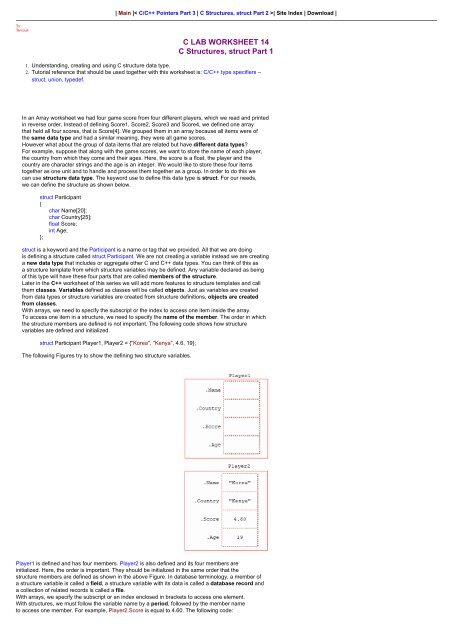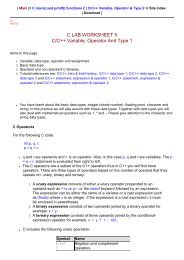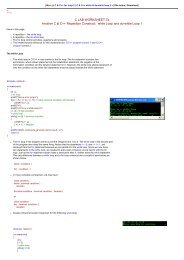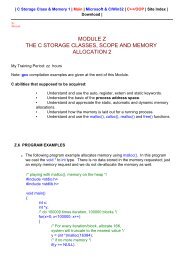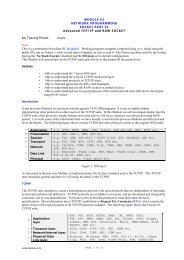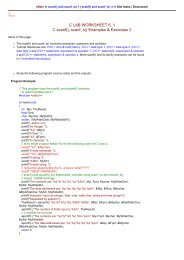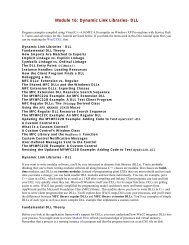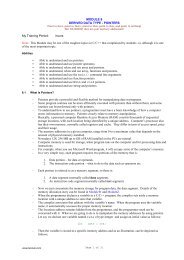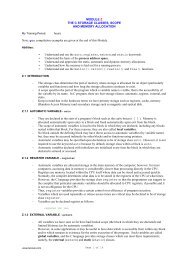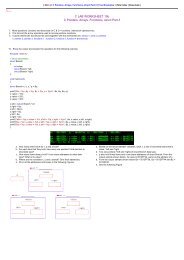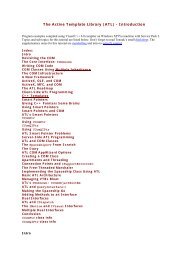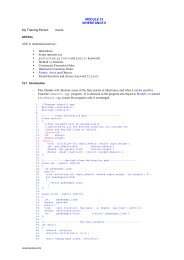struct 1 - Tenouk C & C++
struct 1 - Tenouk C & C++
struct 1 - Tenouk C & C++
You also want an ePaper? Increase the reach of your titles
YUMPU automatically turns print PDFs into web optimized ePapers that Google loves.
| Main |< C/<strong>C++</strong> Pointers Part 3 | C Structures, <strong>struct</strong> Part 2 >| Site Index | Download |C LAB WORKSHEET 14C Structures, <strong>struct</strong> Part 11. Understanding, creating and using C <strong>struct</strong>ure data type.2. Tutorial reference that should be used together with this worksheet is: C/<strong>C++</strong> type specifiers –<strong>struct</strong>, union, typedef.In an Array worksheet we had four game score from four different players, which we read and printedin reverse order. Instead of defining Score1, Score2, Score3 and Score4, we defined one arraythat held all four scores, that is Score[4]. We grouped them in an array because all items were ofthe same data type and had a similar meaning, they were all game scores.However what about the group of data items that are related but have different data types?For example, suppose that along with the game scores, we want to store the name of each player,the country from which they come and their ages. Here, the score is a float, the player and thecountry are character strings and the age is an integer. We would like to store these four itemstogether as one unit and to handle and process them together as a group. In order to do this wecan use <strong>struct</strong>ure data type. The keyword use to define this data type is <strong>struct</strong>. For our needs,we can define the <strong>struct</strong>ure as shown below.<strong>struct</strong> Participant{char Name[20];char Country[25];float Score;int Age;};<strong>struct</strong> is a keyword and the Participant is a name or tag that we provided. All that we are doingis defining a <strong>struct</strong>ure called <strong>struct</strong> Participant. We are not creating a variable instead we are creatinga new data type that includes or aggregate other C and <strong>C++</strong> data types. You can think of this asa <strong>struct</strong>ure template from which <strong>struct</strong>ure variables may be defined. Any variable declared as beingof this type will have these four parts that are called members of the <strong>struct</strong>ure.Later in the <strong>C++</strong> worksheet of this series we will add more features to <strong>struct</strong>ure templates and callthem classes. Variables defined as classes will be called objects. Just as variables are createdfrom data types or <strong>struct</strong>ure variables are created from <strong>struct</strong>ure definitions, objects are createdfrom classes.With arrays, we need to specify the subscript or the index to access one item inside the array.To access one item in a <strong>struct</strong>ure, we need to specify the name of the member. The order in whichthe <strong>struct</strong>ure members are defined is not important. The following code shows how <strong>struct</strong>urevariables are defined and initialized.<strong>struct</strong> Participant Player1, Player2 = {"Korea", "Kenya", 4.6, 19};The following Figures try to show the defining two <strong>struct</strong>ure variables.Player1 is defined and has four members. Player2 is also defined and its four members areinitialized. Here, the order is important. They should be initialized in the same order that the<strong>struct</strong>ure members are defined as shown in the above Figure. In database terminology, a member ofa <strong>struct</strong>ure variable is called a field, a <strong>struct</strong>ure variable with its data is called a database record anda collection of related records is called a file.With arrays, we specify the subscript or an index enclosed in brackets to access one element.With <strong>struct</strong>ures, we must follow the variable name by a period, followed by the member nameto access one member. For example, Player2.Score is equal to 4.60. The following code:
strcpy(Player1.Country, Player2.Country);will copy the country (value) of Player2 as the country of Player1. Additionally, while Player2.Countryis equal to the string “Kenya”, Player2.Country[3] is equal to the character ‘y’. We can always writean array of players like the following.<strong>struct</strong> Participant Player[2];This will create an array called Player[ ] with only 2 slots, where each slot is a <strong>struct</strong>ure of type<strong>struct</strong> Participant. See the following Figure that try to depict an array of <strong>struct</strong>ure.To read in the name for the player in slot 0, the statement will look like this:// scanf("%s, &Player[0].Name);scanf_s("%s, &Player[0].Name, 20);The & is optional here because as you have learned previously, array names are actualaddresses anyway. We can also create a <strong>struct</strong>ure based on other <strong>struct</strong>ures. Consider thethe following code example.<strong>struct</strong> Team // defining a new <strong>struct</strong>ure{<strong>struct</strong> Participant Captain; // <strong>struct</strong> Team contains a <strong>struct</strong>ureint Wins;int Losses;<strong>struct</strong> Participant Player[2]; // <strong>struct</strong> Team has an array of <strong>struct</strong>ures};// defining and initializing a variable<strong>struct</strong> Team SweetThings ={{"Jasmine", "Cambodia", 3.5, 22},5,2,{{"Michael", "Mexico", 5.2, 20},{"Leonard", "Germany", 4.0, 24}}};// just defining a variable<strong>struct</strong> Team RowdyBabies;// need the outer bracesIn the following Figure, you can see what the variable SweetThings looks like, a <strong>struct</strong>ure of <strong>struct</strong>ures.If we want to copy the contents of SweetThings to RowdyBabies, all we need to do is:RowdyBabies = SweetThings;However, for the sake of obtaining experience in handling <strong>struct</strong>ures, let us do the same thing thelong way.
copy the Captain valuesstrcpy(RowdyBabies.Captain.Name, SweetThings.Captain.Name);strcpy(RowdyBabies.Captain.Country, SweetThings.Captain.Country);RowdyBabies.Captain.AgeRowdyBabies.Captain.Score= SweetThings.Captain.Age;= SweetThings.Captain.Score;// copy the Player valuesfor(i = 0; i Auto2.Year)printf("The oldest car is the %s\n", Auto2.Make);elseprintf("They are both the same age!\n");
}<strong>struct</strong> Data Type Practices1. Let us introduce two new functions intended for strings. You may enter “You’remaking me blue” and then enter “All my loving”. Show the output and answer thequestions.#include void main(){char a[25], b[25];puts("Name your favorite song title: ");// gets(a);gets_s(a, 25);puts("\nName another song title:");// scanf("%s", &b);scanf_s("%s", &b, 25);printf("\na = %s, b = %s\n", a, b);}a. Was the scanf_s() able to read the entire string or only the first word?b. Was the gets_s() able to read the entire string or only the first word?c. Did the gets_s() stop reading at the first space or the first return thatwas entered?d. Did the puts() add a ‘\n’ at the end of the string that is printed?e. Which function would you prefer to read in a string, scanf_s() or gets_s()?a. Only the first word.b. The entire string.c. The first return that was entered.d. Yes it did.e. Of course gets()/gets_s().2. Firstly, enter “Ooowee Babe” and then 2.40 for the following program. Show theoutput and answer the questions.#include void main(){// definition of <strong>struct</strong>ure<strong>struct</strong> Song{char Name[25];float Length;};// end of definition// variable declaration<strong>struct</strong> Song Title1;printf("The size of Title1 <strong>struct</strong>ure variable is %d bytes.\n", sizeof(Title1));puts("Name your favorite song title: ");gets_s(Title1.Name, 25);puts("How long is it?");scanf_s("%f", &Title1.Length);printf("\nYour song is ");puts(Title1.Name);printf("And it is %.2f min. long.\n", Title1.Length);}---------------------------------------------------------------Just as the int and float are data types, <strong>struct</strong> Song is a new data type that we have defined.a. What are the two known types used to define <strong>struct</strong> Song?b. <strong>struct</strong> Song is defined with two members. What are their names?c. Do the words char or float by themselves create new variables or allocate space inmemory?d. Since <strong>struct</strong> Song is also a new data type, do you think that it creates in itself a newvariable?e. Is a semicolon used at the end of the <strong>struct</strong>ure definition?f. Since the definition of the <strong>struct</strong>ure doesn’t create a new variable, what is the nameof the variable declared using the <strong>struct</strong> Song data type?g. Title1 is a new variable that takes up space in memory. How many parts does ithave? What are their names?h. Show the contents of each member inside the box Title1.i. An array is a collection of many items of the same data type, such as int or char.Similarly, a <strong>struct</strong>ure data type is a collection of many items. Do they have to be ofthe same data type?a. char and float.b. Name and Length.c. They allocate space in memory.d. Yes it creates in itself a new variable.e. Yes.f. Title1.g. It has two parts named name and length.h. ...


